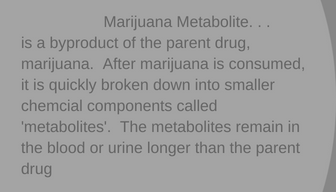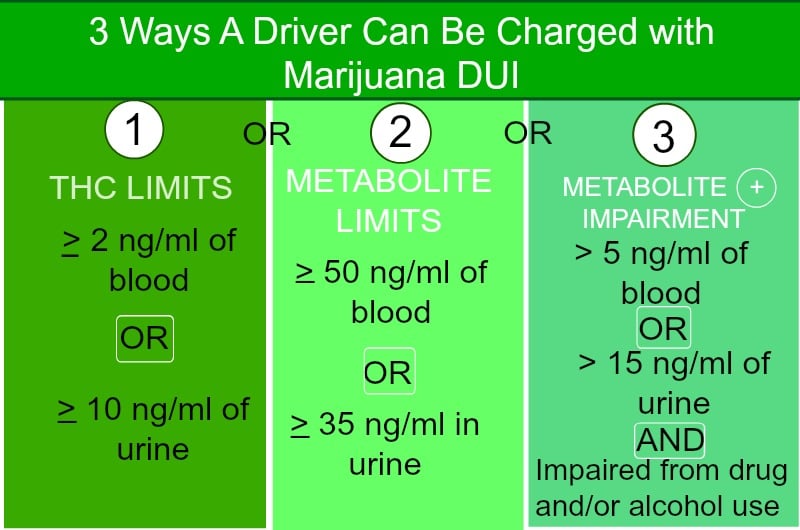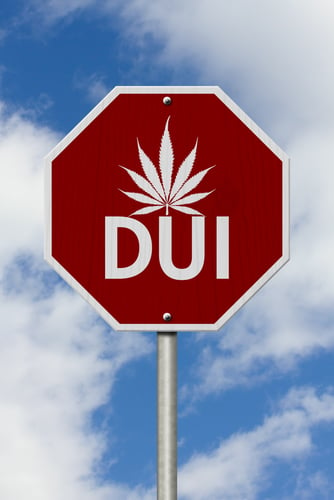After my last article about medical marijuana, I had a number of people ask me for more details about how you can be charged with a DUI for marijuana.
Most people are familiar with the .08 limit for alcohol, but marijuana limits are tested and calculated differently.
And one thing to watch out for: You may not feel “impaired” from marijuana, but you could test over the DUI limit days or even a month after having used the drug.
Breaking: Cincinnati City Council decriminalizes pot use in the city – marijuana OVI law remains the same
Background in DUI/OVI
“DUI” is Driving Under the Influence of Alcohol or Drugs.
“OVI” is Operating a Vehicle Under the Influence of Alcohol or Drugs.
The official language of the Ohio statute governing impaired driving uses the term OVI. For purposes of this article, the terms DUI and OVI are used interchangeably.
Ohio law establishes what is called a “per se limit” for the amount of alcohol or illegal drugs that can be present in a driver’s blood stream before the individual is considered legally impaired. If a breathalyzer, urine, or blood test indicate the presence of these substance in excess of the per se limit, the driver will be charged with OVI.
Two Ways You Can Be Found “Impaired”
OVI statute establishes two ways an individual can be charged with DUI:
1.) observable, circumstantial evidence that indicates impairment
– or –
2.) an excess of the per se limit in the person’s blood stream. The blood content of alcohol or drugs is determined through chemical tests, including the breathalyzer and blood/urine tests.
If a driver is determined by a police officer at the time of a traffic stop to have been impaired by either circumstantial evidence or the failure of a chemical test, the officer will likely charge the driver with OVI.
Per se limits for blood alcohol levels.
Since people are more familiar with alcohol driving laws, it might help to make some comparison to alcohol-related DUI’s in explaining DUI law for marijuana.
Most people are familiar with the per se limit of alcohol of .08 for driving in Ohio. The number .08 refers to the OVI statute language that states that “No person shall operate any vehicle, streetcar, or trackless trolley within this state,” if the concentration of alcohol by weight or volume in the person’s blood stream exceeds .08%.
The per se limit alcohol consumption for drivers under the age of 21 is .02%.
Per se limits for blood marijuana levels: What do the tests measure?
For marijuana, the chemical tests evaluate the presence of marijuana or marijuana metabolite.
The marijuana (or cannabis) plant contains many chemicals. The main chemical of concern for OVI testing is tetrahydrocannabinol, commonly referred to as THC. THC is the chemical component of marijuana that produces a psychoactive effect that causes impairment.
The THC component, in its initial form, metabolizes relatively quickly and is not detectable in a person’s blood or urine for a lengthy time after a person has consumed it.
However, THC metabolite can be detected in blood samples for up to three days. According to a study performed by the Mayo Clinic, metabolite can be detected in in urine samples for up to a month.

The presence of marijuana as well as its metabolites are considered in testing for impairment. Evaluation of blood and urine samples test for the presence of THC in concentrations of nanograms per milliliter (ng/ml). A nanogram is one billionth of a gram.
There are 3 ways an officer can charge a driver with marijuana DUI . An individual can be charged with OVI if marijuana is detected according to any one of the following per se limits:
1.) THC in the amount of 2 ng/ml milliliter in blood; 10 ng/ml in urine.
2.) THC metabolite in the amount of 50 ng/ml of blood, or 35 ng/ml of urine.
3.) the person is exhibiting signs of impairment due to the influence of drugs, alcohol, or some combination of both
– and –
a marijuana metabolite concentration 5ng/ml in the blood or 15 ng/ml in urine.

The breathalyzer: accepted tool for testing blood alcohol content
The vast majority of DUI cases involve drivers allegedly under the influence of alcohol. Officers are well-trained to identify signs of impairment due to alcohol: a strong odor of alcohol, slurred speech, bloodshot eyes, irrational behavior, unstable pupils, unable to walk and turn, unable to stand on one leg, etc.
Most people are familiar with the breathalyzer, a tool used for testing blood alcohol content (BAC). Over the years, the breathalyzer has undergone a good bit of scrutiny and legal challenges. The breathalyzer’s use, calibrations, and overall reliability have been questioned, challenged and litigated, while the courts have wrestled with its legality. Now, the courts generally allow breathalyzer evidence and have determined that is a sufficiently reliable instrument for measuring a person’s BAC.
For our clients, we look for evidence that a breathalyzer test was not administered properly according to law. If the test is administered incorrectly, the results may be thrown out by the court.
Is there a breathalyzer for marijuana?
No.
Tests for BAC can evaluate impairment levels fairly accurately. However, there is currently no such test for evaluating the level of impairment from marijuana use. For this reason, the limits set forth in the statute seem rather arbitrary.
The only approved tests for marijuana impairment are blood and urine tests. While the test for BAC is measured in percentage of alcohol by weight or volume, the tests for blood drug content is measured in nanograms per milliliter of blood or urine. A nanogram is one billionth of a gram.
A person who is over the per se limit for marijuana might not exhibit obvious outward signs of impairment. An officer’s suspicions may still be raised by an odor of marijuana, observation of marijuana or marijuana paraphernalia in the vehicle or on the driver’s person. In such case, the officer will like order a blood or urine test for the driver, even if there is no visible sign of impairment in the driver.
Is there a difference between medical marijuana and recreational marijuana?
No, not for the purposes of charging DUI.
Marijuana is derived from the cannabis plant and contains many different chemicals. The most commonly used chemicals for medical marijuana are cannabidiol and tetrahydrocannabinol (THC). THC is the chemical that causes a person to feel “high”. So, essentially, there is no difference between “recreational marijuana” and medical marijuana containing THC. Some forms of medical marijuana contain a considerable amount of THC; other forms will contain less than would be expected in recreational marijuana.
Marijuana is usually thought of as a drug that is smoked, but smoking is not allowable under Ohio’s medical marijuana law.
Medical marijuana can be dispensed in several different forms including edibles, patches, oils, and vaporized forms.
Patients will be able to obtain marijuana in amounts not exceeding quantities needed for a 90-day supply.
At any given time, a patient may have in his or her possession:
• up to 8 ounces of “tier 1” plant material, containing no more than 23% THC;
• 5.3 ounces of “tier 2” plant material, containing 23.1-35% THC;
• vaping oils in amounts up to 40.5 grams THC;
• patches containing up to 19.8 grams THC;
• edibles containing up to 9 grams of THC.
Is there a difference between medical marijuana and prescription drugs?
Yes.
As long as a driver is not showing other signs of impairment from the drug (such as drowsiness, lack of coordination, etc.), having a prescription for a drug is a defense against DUI. The OVI statute allows drivers to operate a vehicle while using a controlled substance that has been lawfully prescribed by a healthcare professional and has been taken in accordance with the prescription.
However, although medical marijuana is legal in Ohio, it is still classified as a Schedule 1 illegal substance under federal law and is not approved by the FDA to be dispensed by prescription.
Since marijuana is not “prescribable” in Ohio, the law does not allow for the prescription drug defense for marijuana or its metabolites.
Additional legal considerations for medical marijuana patients
Exercise caution with medical marijuana and driving.
When vaped, THC enters the system quickly, and causes a quick “high” feeling that lasts up to an hour.
When consumed through pills and other edibles, the “high” feeling takes longer to take effect, but may last much longer.
People who use marijuana regularly tend to retain greater traces of marijuana and its metabolites for a longer period of time than occasional or one-time users.
It is possible for a person to take medical marijuana and to feel fine for driving after its effects have worn off. In those circumstances it can happen that a person who is not feeling impaired could still fail a test for the per se limit in blood or urine samples.
Remember, you can be charged with DUI if you either show signs of impairment or you fail the per se limit test.
Legal challenges ahead
As with any new area of law, there are bound to be many legal challenges on how OVI charges play out for medical marijuana users. Will Ohio courts be lenient on drivers with a medical marijuana card whose blood/urine content exceeds the official per se limit? That remains to be seen.
We see movement at the federal level from lawmakers who want to remove marijuana from the list of Schedule 1 controlled substances. If that happens, marijuana may then be treated like other controlled substances that are prescribed as medicine.
I will be keeping you updated on our blog with any new developments in the OVI law regarding medical marijuana.
But for now I urge everyone to follow the law as it is written. Never drive while impaired from alcohol, marijuana, any prescription or over-the-counter drug, orany illegal drug. Driving impaired puts yourself and others at risk. It will never be legal.
References:
“Lawriter – OAC – 3796:8-2-04 Quantity of Medical Marijuana That May Be Purchased by a Patient or Caregiver.” Lawriter – ORC – 3313.60 Prescribed Curriculum., codes.ohio.gov/oac/3796:8-2-04v1.
“Lawriter – ORC – 4511.19 Operating Vehicle under the Influence of Alcohol or Drugs – OVI.” Lawriter – ORC – 3313.60 Prescribed Curriculum., codes.ohio.gov/orc/4511.19.Ohio
“Marijuana Δ9-Tetrahydrocannabinol (THC).” GGT – Clinical: Gamma-Glutamyltransferase (GGT), Serum, www.mayomedicallaboratories.com/test-info/drug-book/marijuana.html.
Ohio Board of Pharmacy. “Ohio’s Official Resourcefor the Medical Marijuana Control Program.” Ohio Medical Marijuana Control Program, www.medicalmarijuana.ohio.gov/.


